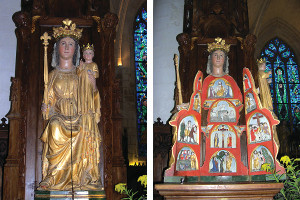launch
SEARCHING FOR STATUES
 photos: Elina Gertsman
photos: Elina GertsmanA late 15th-century Shrine Madonna, closed and open, on display in a Gothic church in Quelven, France.
Art historian Elina Gertsman, PhD, is a self-described master of persistence, a talent she used often as she searched for medieval Virgin Mary statues once so controversial that an 18th-century pope banned them altogether.
"There used to be many, many more Shrine Madonnas," said Gertsman, an associate professor of art history at Case Western Reserve, who estimates at least 38 still exist.
"Many surviving statues are now to be found in towns off the trodden path, and I had to convince a variety of strangers in a variety of languages to let me see these rare objects.
"In some places, they let me paw all over them," she said. "In gloves, of course."
On the outside, the statues appear similar to those images of Mary commonly found in churches, monasteries, and now museums. The Shrine Madonnas, however, feature cabinet-like doors that open to reveal interior paintings and figures. Many include the Trinity inside the Virgin Mary's body—the very reason why, hundreds of years ago, Christian leaders denounced the images as monstrous and theologically erroneous.
"Mary is a figure of purity, and these statues show her hacked open, split up—and they allow fingers to touch her inviolable interior," said Gertsman, who authored the book Worlds Within: Opening the Medieval Shrine Madonna published in April by Penn State Press.
Most of the statues were transformed or destroyed—glued shut, gutted, modified or thrown out. Gertsman spent several years traveling from locales near the Arctic Circle to southernmost France tracking down leads from every source she could locate.
The statues are visually diverse, reflecting their creation in and use across a broad swath of Europe. Some were devotional pieces that aided in prayer; some may have stored relics; some were credited with performing miracles; and at least one became an object of superstition and was opened to induce rain during droughts.
For Gertsman, the Shrine Madonnas provide a prism to view the late Middle Ages, offering insights into a host of things, from drama to medicine. They also suggest a level of cultural complexity that defies popular stereotypes of an unsophisticated medieval world.
"Each one reveals something about that time, its people, their practices of seeing, remembering, worship, and their ways of perceiving the world," she said.






